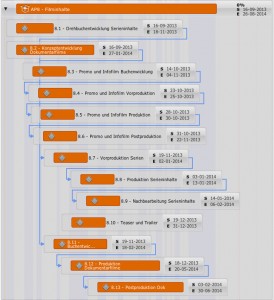Project Overview
“Professor S.” is a revolution on the learning game market – a truly innovative product and the first of its kind worldwide. A prototype of “Professor S.” has been in development since 2009 and has been tested successfully at four primary schools in Berlin during the last school year. The demo version of the “Professor S.” platform is accessible here. The aim of this current project is to develop a market ready version of “Professor S.” and to achieve market introduction. Since “Professor S.” is a new kind of learning game that does not yet exist in this form, the realisation requires research and innovation in various areas. These include:
- Web design
- Programming of web applications
- Didactic methods
- Analysis and quantification of learning successes
- Game mechanics
- New media
Project Risks:
The risks of this project lie in the development and implementation of these technological innovations and also in the execution of the market introduction of “Professor S.”
Technological Risks:
The risk of the development of the HTML5 functions lies mainly in the distribution of appropriate standards and current browser versions of the client systems at the time of the release of the platform. We are planning the parallel integration of established technological solutions like Flash, in order to minimise the overall risk.
The technological risk of the development of game mechanics lies mainly in the impact that a small change in the game design could have on technological elements. Game design is all about human behavior and the way humans deal with the rules of the game. Small changes in these rules can have a surprising impact on the game system. Especially the technological realizations of these rules are then prone to error. This risk will be countered by developing the game rules based on our real world experiences over the last four years and by setting the game mechanics early on in the project, and also to test them, as far as possible, under real conditions. Changes in game design towards the end of the project are to be avoided.
The research for server-client applications for the real time exchange of data with event-driven, non-blocking I/O models is still in its infancy. Thus, the development of such a system holds the risk of missing functions at the end of the development phase. This risk will be countered by the parallel implementation of a Flash-based messaging system.
The semantic communication of URI endpoints and data structures is still in the early stages of development. The risk associated with the development of such a structure will be minimised through the parallel development of a traditional API documentation.
Economic Risks:
The core element of our market introduction strategy is the fact that our product was developed inside schools and that it continues to be supported by schools and teachers. We therefore also have an in-built support for the distribution of the home version because children playing the game in the school will also be able to use it at home. The cost of using indirect marketing methods will therefore be reduced. To reach the critical mass (2% of the target audience) we need a network of schools that put “Professor S.” to use. Like in a neural network, we use the reach of teacher recommendations to propagate the advantages of “Professor S.” That is also why we don’t market "Professor S." to schools in a traditional way (with sales representatives), but rather, rely on word of mouth among teachers and the support of other schools in the region that already play “Professor S.”. This lends credibility to our product. Both the school and the home version are supported and validated in this way. Initially, we plan to cover the regions of Berlin, Brandenburg, Saxony, Saxony-Anhalt and Thüringen.
But what happens when the word of mouth technique does not deliver the expected results? To approach our core target group, the schools, we will simultaneously reach out through extensive publicity work. This will include carefully planned and targeted trade show appearances. The focus is on positive experiences at other schools and the effectiveness of the didactic principle of “Professor S.” We will accompany this work through community management in relevant online forums. The aim is to establish “Professor S.” at a critical number of schools within one federal district. Even if not all schools fit the distributing role, we will still reach a certain visibility that makes the distribution of the product much easier. This may be effective but also quite time-consuming. The effects of this strategy show through in the projected numbers. The low-expect result should be realizable within three years.
Another challenge is the fragmented nature of federal curricula: Every federal district has its own framework curriculum. The modular structure of “Professor S.” content however allows for a flexible adaptation to fit the indivdidual requirements. Researching the differences between the curricula of the various districts is included in the planned work as part of WP9. The results of this research will flow into the design of the content (tasks, films, messages).
